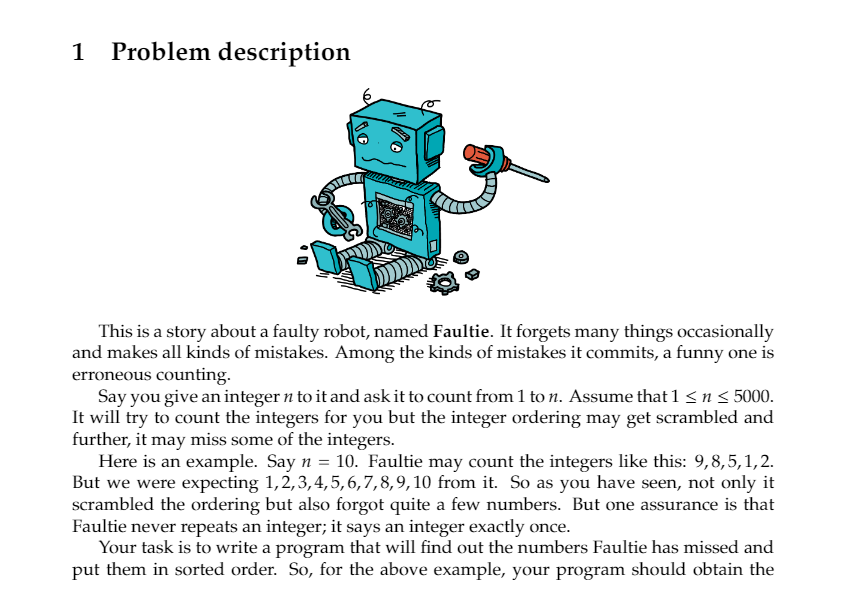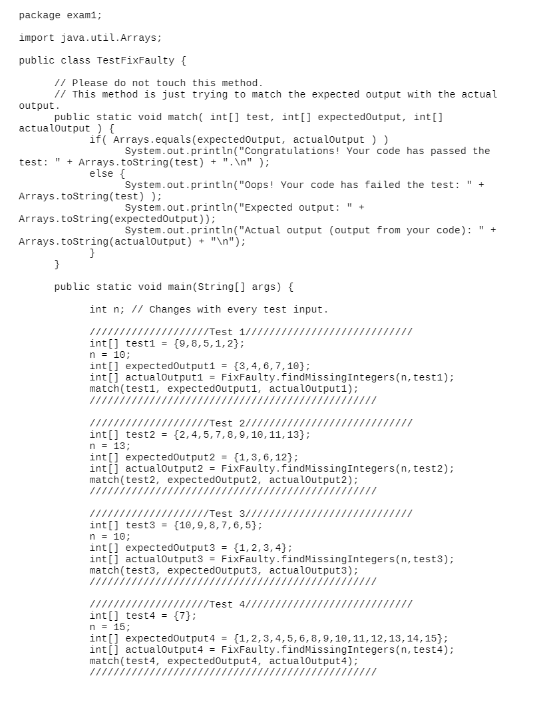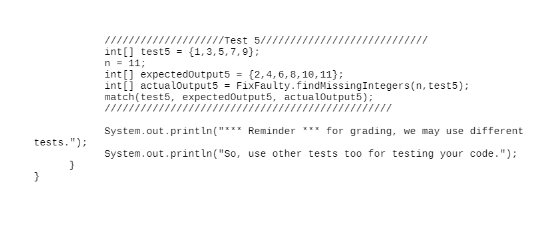

FixFaculty.java TestFixFaculty.java
TestFixFaculty.java


1 Problem description This is a story about a faulty robot, named Faultie. It forgets many things occasionally and makes all kinds of mistakes. Among the kinds of mistakes it commits, a funny one is erroneous counting. Say you give an integer n to it and ask it to count from 1 to n. Assume that 1 sn s 5000. It will try to count the integers for you but the integer ordering may get scrambled and further, it may miss some of the integers. Here is an example. Say n = 10. Faultie may count the integers like this: 9,8,5,1,2. But we were expecting 1,2,3,4,5,6,7,8,9,10 from it. So as you have seen, not only it scrambled the ordering but also forgot quite a few numbers. But one assurance is that Faultie never repeats an integer; it says an integer exactly once. Your task is to write a program that will find out the numbers Faultie has missed and put them in sorted order. So, for the above example, your program should obtain the following sequence: 3,4,6,7,10. Observe that not only the missing numbers are obtained but also they are put in sorted order. Hint: there is an O(n) algorithm for this problem. Although your algorithm may have a worse time complexity, thinking about a O(n) time algorithm should be fun! No extra points for this though. This coding problem does not require any kind of file handling. This project has two classes only: HelpFaulty and TestHelpFaulty. For more information and sample tests, refer to the code outline. Make sure you understand the sample inputs and outputs well before you start coding. ** @author Type your full name (as it appears in Canvas) */ package exam1; public class FixFaulty { public static int[] findMissingIntegers(int n, int[] faultysoutput) { int[] answer = new int[n-faultysoutput. length]; ***/ // Your code goes right here. You may use helper methods if you want to. // You are not allowed to use any built-in Java data structures such as LinkedList, ArrayList, etc. // However, you can use arrays, as you did in your previous programming courses. **/ /** return answer; } } package exami; test: import java.util.Arrays; public class TestFixfaulty { // Please do not touch this method. // This method is just trying to match the expected output with the actual output. public static void match( int[] test, int[] expectedoutput, int[] actua loutput ) { if( Arrays.equals(expectedoutput, actualoutput ) ) System.out.println("Congratulations! Your code has passed the + Arrays.tostring(test) + ", "); else { System.out.println("Oops! Your code has failed the test: " + Arrays.toString(test) ); System.out.println("Expected output: " + Arrays.tostring(expectedoutput)); System.out.println("Actual output (output from you code): " + Arrays.tostring(actualoutput) + " "); } public static void main(String[] args) { int n; // Changes with every test input. M/Test 1/11 int[] testi - (9,8,5,1,2}; n = 10; int[] expectedOutput1 = {3,4,6,7,10); int i actualOutput1 = FixFaulty.findmissingIntegers(n, test1); match(testi, expectedoutputi, actualoutputi); //////Test 2/////// int[] test2 = {2,4,5,7,8,9,10,11,13}; n = 13; int[] expectedOutput2 = (1,3,6,12}; intij actualOutput2 = FixFaulty.findMissingIntegers(n, test2); match(test2, expectedOutput2, actualOutput2): /Test 3/11 int[] test3 = {10,9, 8, 7, 6,5}; n = 10; int[expectedoutput3 = {1,2,3,4}; int[] actualOutput 3 = FixFaulty.findMissingIntegers(n, test3); match(test3, expectedoutputs, actualoutput3); /////Test int[] test4 = {7}; n = 15; int[] expectedoutput 4 = {1,2,3,4,5,6,8, 9, 10, 11, 12, 13, 14, 15); intii actualOutput 4 = FixFaulty.findMissing Integers(n, test4); match(test4, expectedOutput4, actualOutput 4); M/Test 5/7 int[] test5 = {1,3,5,7,9); n = 11; int[] expectedoutputs = {2,4,6,8,10,11}; int[] actualoutput 5 = FixFaulty.findMissing Integers(n, test5); match(tests, expectedOutputs, actualOutput 5); tests."); System.out.println("*** Reminder *** for grading, we may use different System.out.println("So, use other tests too for testing your code."); } }


 TestFixFaculty.java
TestFixFaculty.java







